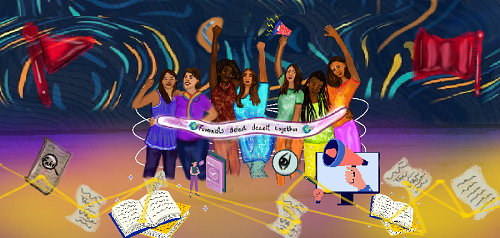Gendered Disinformation puts Women Human Rights Defenders at Risk: Here’s how

Women human rights defenders (WHRDs) — women and girls working on any human rights issue, or people of any gender(s) working to promote gender equality (which might also include civil society actors who work in non-traditional fields such as journalists, health workers and private actors) — are an integral part of communities around the world.
They play a critical role in upholding the human rights of their communities and defending their territories. According to Office of the High Commissioner on Human Rights (OHCHR), “WHRD's individual and collective action has been pivotal in addressing discrimination and inequality and advancing civil, political, economic, social and cultural rights, including in the context of prevention, peace and security and sustainable development. They have been at the forefront of social justice movements towards genuine social changes that have benefited everyone.”2
This makes many WHRDs engage with public-facing roles as they advance important conversations and advocacy, and also puts them at higher risk of all forms of violence — this happens because often, they are perceived as challenging the status quo and “traditional” ideas of family and gender in society. This perception often generates hostility from people around them, including State actors and authoritarian forces, as well as from the media, faith-based groups, the community, family and other non-State actors — which might also include corporate vested interests. Although all defenders are at risk of violence, women human rights defenders are often amongst the first to come under attack.
These attacks take place in digital spaces too — gendered abuse, threats of violence, spam, doxxing, and other forms of online gender-based violence (OGBV) are common tools. And gendered disinformation, a form of OGBV that uses lies and malicious narratives by coordinated actors, is becoming an increasingly common form of attack.
Gendered disinformation affects the lives of women human rights defenders in many ways. When attackers use gendered biases and sexual double standards to reduce the credibility of WHRDs’ work, they aim to silence them and stop their free participation in the digital publics — at the very least. WHRD have lies spread about them, either through malicious stories or morphed media, and a common strategy is using highly emotive and value-laden content which is tailored to local contexts. Their competence is undermined, and the aim is to stigmatise and isolate them.
As Deeyah Khan, Film director and UNESCO Goodwill Ambassador, says: “The kind of threats that I got were not just simply talking about the various ways that I was going to be killed, but they were also highly gendered in the sense that they would talk about the fact that I would be raped before I would be killed, the fact that I would be sexually assaulted and violated and abused.”
Ukrainian MP Svitlana Zalishchuk was attacked by gendered disinformation in 2017 when she spoke at the UN about her country’s war with Russia and its impact on women. When Zalishchuk told world leaders that Ukrainian women have had to shift their focus “from equality to survival,” it put the focus on her — soon afterwards, a fake tweet circulated that said that the MP had promised to run naked through the streets of Kiev if the Ukrainian army lost an important battle to the Russia-backed separatists. The campaign was accompanied by fake images of her naked. “It was all intended to discredit me as a personality, to devalue me and what I’m saying.”
In conservative societies, these attacks pose the risk of increased harm to WHRD as gendered disinformation can be used effectively to attack the “honour” or reputation of women human rights defenders. This is because in traditional societies, women are often dependent on families and communities for protection — and gendered disinformation can put women in a vulnerable position, as such coordinated shaming and intimidation might lead to family members, colleagues and neighbours turning against them.
A study from the Iniciativa MesoAmericana de Defensoras (MesoAmerican Initiative of Women Human Rights Defenders) found that from 2012 to 2014, at least 5% of assaults against WHRD were perpetrated “within WHRDs’ immediate environment” — mostly by male family members and colleagues.6
As Irene Khan, the Special Rapporteur on the promotion and protection of freedom of opinion and expression, says: “Online attacks against women take on a snowball effect as they move across platforms, use coded language to escape detection, mobilize and grow exponentially. They move between the offline and online world in ways that can also sometimes lead to physical violence.”
Aside from the physical violence that online gender-based violence puts WHRD at risk of, there are also larger repercussions of gendered disinformation on the functioning of our societies and democracies. When woman human rights defenders censor themselves, it reduces the diversity of opinions in public spaces, and gradually erodes the free and fair functioning of democratic societies — which is ultimately the larger aim of deploying gendered disinformation against WHRD.
Irene Khan echoed this statement when she said, “The ultimate aim of gendered disinformation is to reduce the diversity of voices and views, and undermine inclusive, democratic societies and the collective struggle for gender equality.”
She also emphasised the need to make digital spaces safer without eroding the human rights granted to each one of us: “While it is imperative to make digital spaces safe, measures to do so must not restrict freedom of expression beyond what is permitted under international human rights law, or the results will be counter-productive.”
Artist: Imaan Jufeer
Image description: A group of diverse women in the center are surrounded by interconnected ways of publishing information and connection, like books, computers and phones. There are a couple of red flags on the sides, and the banner in the middle says: Feminists defeat deceit together.
- Log in to post comments
